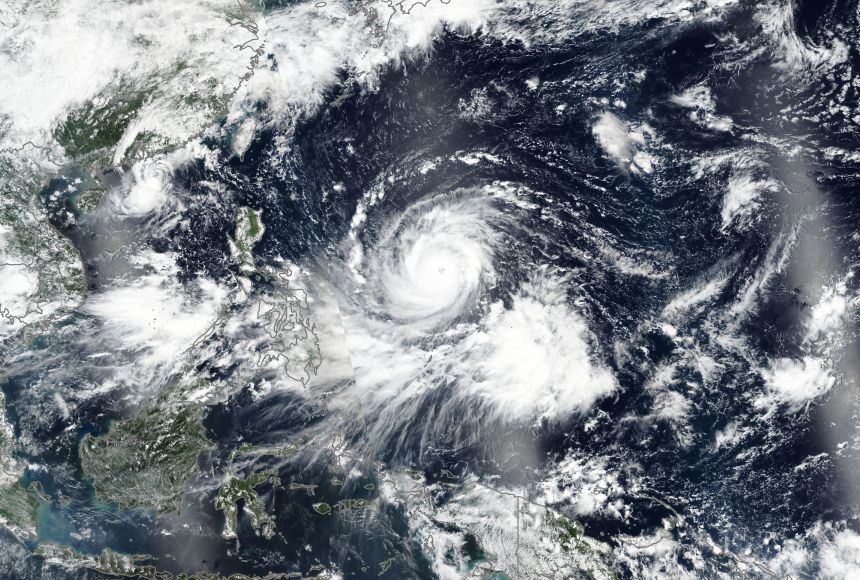This article was originally published August 8, 2019
Hurricane Florence, a massive hurricane, is on course to hit the United States East Coast. Meanwhile, on the other side of the world, regions of Southeast Asia are about to be hit by Super Typhoon Mangkhut. People in the Philippines call it the Super Typhoon Ompong. This part of the globe is bracing to be devastated by the storm's enormous potential for damage.
Super Typhoon Mangkhut's winds are estimated at 253 kilometers (157 miles) per hour. These wind speeds are powerful enough to overturn a train or even collapse a building. Mangkhut threatens the coasts of Hong Kong and Macau where millions of people live, and its great rains have already caused flooding in Guam. It is likely to strengthen in the coming hours and strike the Philippines further along its path.
The storm brewing on the U.S. East Coast, Florence, is called a hurricane, while the storm in Southeast Asia is referred to as a super typhoon. Hurricanes, typhoons, and cyclones are actually different names for the same type of storm. The name of the storm comes from its location on the globe.
What's in a Name?
The storms that rage across the western Pacific Ocean in the Eastern Hemisphere are called typhoons. The ones spawned in the Atlantic and eastern Pacific in the Western Hemisphere are called hurricanes.
The names also come from different cultures and origins in language. Hurricanes are named after Hurrican, a Caribbean god of evil. "Typhoon" has roots in Persian, Arabic, and Chinese words that referred to strong storms and has also been handed down through numerous other languages, from Portuguese to Greek.
Both Hurricanes and Typhoons are categorized by their intensity. Scientists call both hurricanes and typhoons "tropical cyclones." To classify as a "tropical cyclone" a storm must reach wind speeds of at least 119 kilometers (74 miles) per hour. If a storm's winds reach speeds of 178.6 kilometers (111 miles) per hour, it is upgraded to an intense hurricane or typhoon. These storms can expand to an area up to 1,609 kilometers (1,000 miles) in diameter.
Scientists measure hurricanes on a scale from 1 to 5. Typhoons are classified differently by different countries. The weather agency of Hong Kong classifies typhoons as: typhoon, severe typhoon, and super typhoon. With its 253-kilometer (157-mile-)-per-hour winds, Super Typhoon Mangkhut would be a Category 5 hurricane if it was located in the Atlantic Ocean.
The Science of Storms
Which is more common, hurricanes or typhoons? Kerry Emanuel is a scientist who studies these types of storms at the U.S. university the Massachusetts Institute of Technology. He explains that hurricanes in the Atlantic get the most media coverage in the U.S., but they only account for 11 percent of all tropical cyclones.
Once a storm gets going, it is fueled by the evaporation of water into the air. Warm ocean waters feed that evaporation, cooling the immediate area and sucking more heat to the center of the storm. This sets up a cycle that keeps running until one or more of several factors stop it.
Those factors can include high wind speed at certain angles. This wind breaks up the storm or slows it down by blasting it with dry air. The churning winds also can pull up cold water from deep in the ocean, which results in less evaporation potential and robs the storm of power. Also, the storm's contact with the land slows it down. When a storm touches land, it no longer evaporates the large amounts of ocean water that gave the storm its energy.
The storms are categorized by the strength of their winds, but the wind itself often isn't the deadliest part of the tempest. Storm surges, which are pulses of water pushed by the advancing cyclone, cause coastal flooding. These storm surges can drown towns and buildings.
Surges were responsible for much of the devastation caused by Super Typhoon Haiyan in the Philippines in November 2013. Haiyan was one of the largest and strongest storms ever recorded. Its winds reached 315 kilometers (196 miles) per hour. Storm surges as high as 7.6 meters (25 feet) washed away buildings, ripped up vegetation, and killed over 6,000 people.
The Summer Months Are Storm Season
Tropical cyclones develop most often in late summer because of the great difference in temperature between the air and water. May is the least active month. In the Atlantic, hurricane season is from June through November, after which, the air and water get too cool for the storms to develop.
In some parts of the western Pacific Ocean, the conditions are warm enough for typhoons to develop at any time during the year. Still, the summer and early fall are the most common periods for typhoons.
No matter what the storms are called, they all need the same things: storm clouds, surface ocean temperatures above 27 degrees Celsius (80 degrees Fahrenheit), and very little difference in wind speeds from the surface to high in the sky. Beyond that, scientists, like Emanuel, are still trying to understand what exactly triggers these destructive storms.
Emanuel, who studies these storms, is worried about the effects of climate change. The earth's continual warming air and water may make these powerful storms more common.
